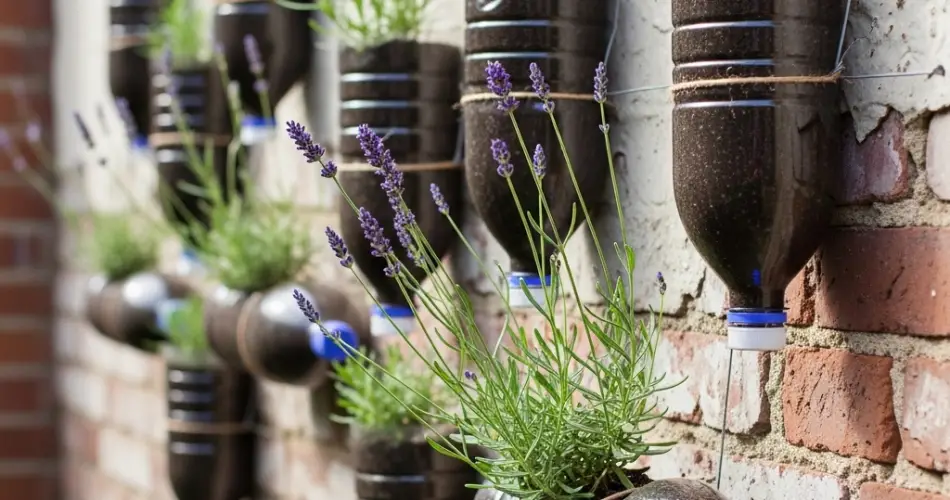Creating a vibrant, fragrant garden doesn’t always require a yard or large pots. Wall-mounted bottle planters offer an innovative and eco-friendly solution for growing lavender in small spaces. By repurposing plastic bottles, you can design a vertical garden that is visually appealing, space-saving, and fragrant, while also contributing to sustainable living. This guide will walk you through each step of building a beautiful lavender wall garden.
Choosing the Right Bottles
Plastic bottles are versatile, affordable, and perfect for vertical gardening. Standard 1- or 2-liter bottles are ideal, but smaller bottles can also be used depending on the size of your wall and the scale of your project. Make sure the bottles are clean, free of labels, and sturdy enough to support soil and plants. For added personality, consider painting or decorating the bottles, or leaving them clear for a minimalist aesthetic. UV-resistant paint is recommended if the garden will be outdoors.
Preparing Bottles for Planting
The preparation process is simple but essential. Start by cutting an opening on the side of each bottle to create space for planting. Horizontal cuts produce a small trough, while vertical cuts allow for more planting room and a staggered design. Drill or poke drainage holes at the bottom to prevent water from pooling and damaging the roots. These steps ensure that your lavender plants have enough room to grow and stay healthy.
Choosing Lavender Varieties
Lavender is an excellent choice for vertical gardens due to its compact growth habit and aromatic properties. Some popular options include English lavender (Lavandula angustifolia), French lavender (Lavandula dentata), and Spanish lavender (Lavandula stoechas). English lavender is particularly prized for its strong fragrance and dense, bushy appearance. Choose a variety that suits your climate and the available sunlight in your chosen wall location.
Planting Lavender
Use a well-draining potting mix suitable for Mediterranean herbs when filling the bottles. Lavender prefers soil that is light and slightly sandy; avoid heavy or nutrient-rich soils that may retain too much moisture. Plant lavender seedlings gently, covering the roots with soil and pressing lightly to secure the plant. Water the seedlings lightly after planting to help them settle into their new environment.
Designing the Wall Layout
Your wall’s layout plays a crucial role in both aesthetics and plant health. Staggered or grid patterns are popular choices, ensuring each plant receives sufficient sunlight. If the wall is exposed to strong wind, placing the bottles closer together can provide extra protection. For added visual appeal, paint the bottles in coordinating colors, or mix clear and painted bottles for a modern, dynamic look.
Mounting the Bottles
Securing the bottles to the wall requires attention to stability. Heavy-duty hooks, brackets, or wire mesh can hold the weight of the soil and plants securely. Ensure each bottle is anchored firmly to prevent tipping or falling, particularly for outdoor installations. A slight forward tilt helps with water drainage. For indoor walls, lighter mounting options, such as adhesive hooks or small racks, may suffice.
Care and Maintenance
Lavender requires minimal but consistent care to thrive in vertical planters. It thrives in full sunlight, so select a location that receives at least six hours of direct light daily. Water moderately, allowing the soil to dry slightly between watering sessions to prevent root rot. Fertilize sparingly using a balanced, slow-release fertilizer, or choose organic alternatives such as compost tea. Regular pruning of stems and spent flowers encourages new growth and maintains a tidy appearance.
Maximizing Fragrance and Visual Appeal
One of the greatest benefits of a lavender wall is its fragrance. Position your wall-mounted garden near walkways, patios, or seating areas to enjoy the aromatic effect. To create a richer sensory experience, combine lavender with other herbs like rosemary, thyme, or mint, which complement both the fragrance and visual texture of the garden. Over time, the wall becomes a lush, aromatic backdrop that enhances any indoor or outdoor space.
Sustainability Benefits
A vertical lavender garden is not only beautiful but also environmentally friendly. Repurposing plastic bottles helps reduce waste, while vertical gardens maximize space efficiency, making them ideal for apartments, small yards, or urban environments. Vertical gardens can also improve air quality, provide insulation for walls, and create a soothing natural environment in otherwise limited spaces.
By following these steps, you can build a stunning lavender wall using recycled bottles. The combination of fragrant blooms, vibrant greenery, and creative design transforms any wall into a practical and beautiful garden feature. With proper care and positioning, your wall-mounted lavender planters will continue to thrive, providing year-round beauty, scent, and a touch of sustainable charm.



